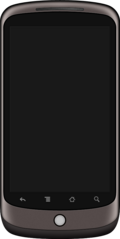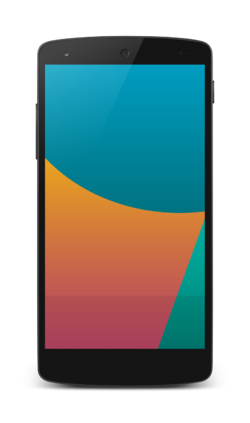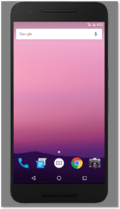The following is a comparative list of smartphones belonging to the Google Nexus line of devices, using the Android operating system.
| Model | Nexus One | Nexus S | Galaxy Nexus | Nexus 4 | Nexus 5 | Nexus 6 | Nexus 5X | Nexus 6P |
|---|---|---|---|---|---|---|---|---|
| Status | Discontinued, unsupported | |||||||
| Manufacturer | HTC | Samsung | LG | Motorola Mobility | LG | Huawei | ||
| Model Codename | Passion | Crespo / crespo4g | Maguro/Toro/Toroplus | Mako | Hammerhead | Shamu | Bullhead | Angler |
| ROM Codename | passion / passion_vf | soju / sojua / sojuk /sojus | yakju / takju / mysid /micacea | occam | Hammerhead | Shamu | Bullhead | Angler |
| Released | January 2010 | December 2010 | October 2011 | October 2012 | October 2013 | October 2014 | October 2015 | |
| Discontinued | July 19, 2010 [1] | May 24, 2012 (Sprint) [2] June 8, 2012 (Mobilicity) [3] | October 29, 2012 (Google Play Store) [4] | November 1, 2013 (Google Play Store) [5] [6] | March 12, 2015 [7] | December 9, 2015 | October 4, 2016 | |
| Image |  |  |  |  |  |  |  |  |
| Android version | 2.1 Eclair | 2.3 Gingerbread | 4.0.1 Ice Cream Sandwich | 4.2 Jelly Bean | 4.4 KitKat | 5.0 Lollipop | 6.0 Marshmallow | |
| Upgradable to | 2.3.6 Gingerbread | 4.1.2 Jelly Bean | 4.3 Jelly Bean | 5.1.1 Lollipop | 6.0.1 Marshmallow | 7.1.1 Nougat | 8.1 Oreo [8] | |
| Last updated | September 2011 | October 2012 | July 2013 | April 2015 | October 2015 | January 2017 [9] | December 2017 | |
| Cellular frequencies | GSM 850/900/1800/1900 MHz UMTS 850/1900/2100 MHz or 900/1700/2100 MHz | GSM 850/900/1800/1900 MHz UMTS 900/1700/2100 MHz or 850/1900/2100 MHz CDMA2000 (4G version) | GSM 850/900/1800/1900 MHz UMTS 850/900/1700/1900/2100 MHz LTE 1900 MHz (LTE-only version) | GSM 850/900/1800/1900 MHz UMTS 850/900/1700/1900/2100 MHz LTE 1700 MHz hardware (disabled in software) | GSM 850/900/1800/1900 MHz UMTS 850/900/1700/1900/2100 MHz LTE (US) bands: 1/2/4/5/17/19/25/26/41 | GSM 850/900/1800/1900 MHz LTE(US) bands: 2/3/4/5/7/12/13/17/25/26/29/41 CA DL bands: B2-B13, B2-B17, B2-29, B4-B5, B4-B13, B4-B17, B4-B29 | GSM 850/900/1800/1900 MHz LTE(US) bands: 1/2/3/4/5/7/10/12/13/17/25/26/29/41 CA DL bands: B2-B2, B2-B4, B2-B5, B2-B12, B2-B13, B2-B17, B2-B29, B4-B4, B4-B5, B4-B7, B4-12, B4-B13, B4-B17, B4-B29, B41-B41 | GSM 850/900/1800/1900 MHz LTE(US) bands: 2/3/4/5/7/10/12/13/17/25/26/29/30/41 CA DL bands: B2-B2, B2-B4, B2-B5, B2-B12, B2-B13, B2-B17, B2-B29, B4-B4, B4-B5, B4-B13, B4-B17, B4-B29, B41-B41 |
| Data speeds | GPRS Class 10 HSUPA 2 Mbit/s HSDPA 7.2 Mbit/s | HSUPA 5.76 Mbit/s HSDPA 7.2 Mbit/s WiMAX (4G version) | HSUPA 5.76 Mbit/s HSDPA 21 Mbit/s | HSDPA 42 Mbit/s HSPA+ DC-HSPA+ | ||||
| Size | 119 mm (4.7 in) H 59.8 mm (2.35 in) W 11.5 mm (0.45 in) D | 123.9 mm (4.88 in) H 63.0 mm (2.48 in) W 10.8 mm (0.43 in) D | 135.5 mm (5.33 in) H 67.94 mm (2.675 in) W 8.94 mm (0.352 in) D 9.47 mm (0.373 in) D (LTE version) | 133.9 mm (5.27 in) H 68.7 mm (2.70 in) W 9.1 mm (0.36 in) D | 137.84 mm (5.427 in) H 69.17 mm (2.723 in) W 8.59 mm (0.338 in) D | 159.26 mm (6.270 in) H 82.98 mm (3.267 in) W 10.06 mm (0.396 in) D | 147.0 mm (5.79 in) H 72.6 mm (2.86 in) W 7.9 mm (0.31 in) D | 159.3 mm (6.27 in) H 77.8 mm (3.06 in) W 7.3 mm (0.29 in) D |
| Weight | 130 g (4.6 oz) | 129.0 g (4.55 oz) (AMOLED version) 140.0 g (4.94 oz) (Super-Clear LCD version) | 135 g (4.8 oz) | 139 g (4.9 oz) | 130 g (4.6 oz) | 184 g (6.5 oz) | 136 g (4.8 oz) | 178 g (6.3 oz) |
| Chipset | Qualcomm Snapdragon 8250 | Samsung Exynos 3 | Texas Instruments OMAP 4460 | Qualcomm Snapdragon S4 Pro | Qualcomm Snapdragon 800 | Qualcomm Snapdragon 805 | Qualcomm Snapdragon 808 | Qualcomm Snapdragon 810 |
| Processor | 1 GHz Qualcomm Scorpion | 1 GHz single-core ARM Cortex-A8 | 1.2 GHz dual-core ARM Cortex-A9 | 1.5 GHz quad-core Qualcomm Krait 200 | 2.26 GHz quad-core Qualcomm Krait 400 | 2.65 GHz quad-core Qualcomm Krait 450 | 1.8 GHz hexa core 64-bit ARMv8-A | 2.0 GHz octa core 64-bit ARMv8-A |
| Graphics | Qualcomm Adreno 200 @ 133 MHz | PowerVR SGX540 @ 200 MHz | PowerVR SGX540 @ 384 MHz [10] | Qualcomm Adreno 320 @ 400 MHz | Qualcomm Adreno 330 @ 450 MHz | Qualcomm Adreno 420 @ 600 MHz | Adreno 418 | Adreno 430 |
| Memory | 512 MB LPDDR | 1 GB LPDDR2 | 2 GB LPDDR2 | 2 GB LPDDR3 | 3 GB LPDDR3 | 2 GB LPDDR3 | 3 GB LPDDR4 | |
| Storage | 512 MB + expandable SD | 16 GB iNAND (partitioned 1 GB internal storage) | 16 or 32 GB [11] [12] | 8 or 16 GB | 16 or 32 GB | 32 or 64 GB | 16 or 32 GB | 32 or 64 or 128 GB |
| Expandable storage | microSDHC slot (up to 32 GB card supported) | — | ||||||
| New connectivity | 3.5 mm TRRS A-GPS Bluetooth v2.1 + EDR micro USB 2.0 Wi-Fi IEEE 802.11b/g/n | NFC | DLNA USB On-The-Go MHL Bluetooth 3.0 (Bluetooth 4.0 compatible hardware) Wi-Fi 802.11a/b/g/n | SlimPort Miracast Bluetooth 4.0 Qi wireless charging Removes USB On-The-Go Removes MHL in favor of SlimPort | 802.11a/b/g/n/ac USB On-The-Go [13] | removes SlimPort | USB-C removes Qi wireless charging [14] | |
| WLAN/BT | Broadcom BCM4329 [15] | Broadcom BCM4329 [16] | Broadcom BCM4330 [17] | Qualcomm | Broadcom BCM4339 [18] | Broadcom BCM4354 | Qualcomm QCA6174 [19] | Broadcom BCM4358 [20] |
| GPS | Qualcomm | ? | CSR GSD4T 9600 | Qualcomm | Qualcomm | ? | ? | ? |
| NFC | — | NXP PN544 [21] | NXP PN65N | BCM20793S | BCM20793M | BCM20795 | NXP PN548 | |
| Power | 1,400 mAh User-replaceable lithium-ion battery | 1,500 mAh User-replaceable lithium-ion battery | 1,750 mAh (HSPA+ version) [22] 1,850 mAh (LTE version) [23] User-replaceable battery | 2,100 mAh Non-user-replaceable lithium polymer battery, Wireless charging | 2,300 mAh Non-user-replaceable lithium polymer battery | 3,220 mAh Non-user-replaceable lithium polymer battery with Turbo Charging technology | 2,700 mAh | 3,450 mAh |
| Face buttons | Capacitive touch-sensitive buttons | On-screen buttons | ||||||
| New features | Multi-touch capacitive touchscreen 3-axis accelerometer A-GPS Ambient light sensor Microphone Digital compass Proximity sensor Trackball | Digital compass Wi-Fi hotspot USB tethering Oleophobic display coating SIP VoIP Removes trackball | Barometer 3-axis digital compass Dual microphones for active noise cancellation Wi-Fi Direct Oleophobic display coating | Wireless charging Crystal Reflection Glass back Gorilla Glass 2 DC-HSPA+ | LTE, 802.11 a/b/g/n/ac Wi-Fi Composite step detector and step counter Gorilla Glass 3 [24] Removes Crystal Reflection Glass back | Dual front-facing speakers on long axis | Fingerprint Sensor Removes Dual front-facing speakers on long axis | Fingerprint Sensor Dual front facing speakers on long axis |
| Display | At launch: AMOLED Later: SuperLCD 3.7 in (94 mm) 480×800 px (254 ppi) 9:15 aspect ratio 24-bit color 100,000:1 contrast ratio 1 ms response time | 4.0 in (100 mm) Super AMOLED PenTile [25] or Super Clear LCD display (GT-i9023) 480×800 px (233 ppi) 9:15 aspect ratio | 4.65 in (118 mm) HD Super AMOLED PenTile [26] 720×1280 px (316 ppi) 9:16 aspect ratio 10 μs response time[ citation needed ] | 4.7 in (120 mm) "TrueHD+" IPS 768x1280 px (320 ppi) 9:15 aspect ratio | 4.95 in (126 mm) "TrueHD+" IPS 1080×1920 px (445 ppi) 9:16 aspect ratio | 5.96 in (151 mm) AMOLED PenTile 1440x2560 px (493 ppi) 9:16 aspect ratio | 5.2 in (130 mm) LCD 1080×1920 px (423 ppi) 9:16 aspect ratio | 5.7 in (140 mm) AMOLED 1440x2560 px (518 ppi) 9:16 aspect ratio |
| Rear camera | 5 MP (2,560×1,920) 480p (720×480) video recording @ 20 fps or higher LED flash | 5 MP (2,560×1,920) LED flash [27] | 5 MP (2,592×1,936) 1080p (1920×1080) video recording @ 24 fps [28] LED flash Zero shutter lag [29] | 8 MP (3,264×2,448) back-side illuminated sensor 1080p (1920×1080) video recording @ 30 fps LED flash | 8 MP (3,264×2,448) sensor 1080p (1920×1080) video recording @ 30 fps LED flash Optical image stabilization | 13 MP sensor Optical image stabilization Dual LED ring flash f/2.0 aperture 4K video capture at 30 fps | 12.3 MP, F2.0, laser autofocus | |
| Front camera | — | 0.3 MP (640×480) | 1.3 MP 720p (1280x720) video recording @ 30 fps [28] | 2 MP | 5 MP | 8 MP | ||
| SIM card format | Mini-SIM | Micro-SIM | Nano-SIM | |||||
| Media formats | Audio AAC, AAC+, eAAC+, AMR-NB, AMR-WB, MP3, MIDI, Ogg, WAV Image BMP, GIF, JPEG, PNG Video H.263, H.264, MPEG-4 SP | Audio AAC, AAC+, eAAC+, AMR, AMR-NB, MP3, Ogg Video H.264, H.263, MPEG-4, VP8 | Audio AAC, AAC+, eAAC+, AC3, FLAC, MP3, Vorbis, WAV Video H.263, H.264, MP4, WebM | Audio AAC, AAC+, eAAC+, MIDI, MP3, WAV Video H.263, H.264, MP4 | ? | ? | ? | |
| References | [30] [31] [32] [33] [34] | [35] | [36] | [37] | ||||